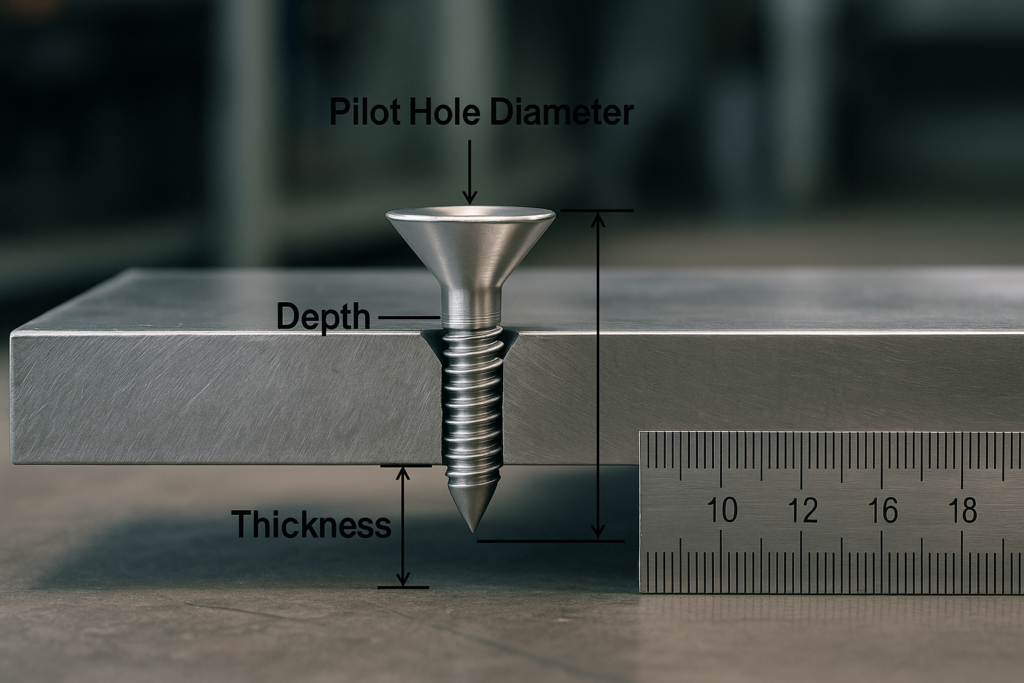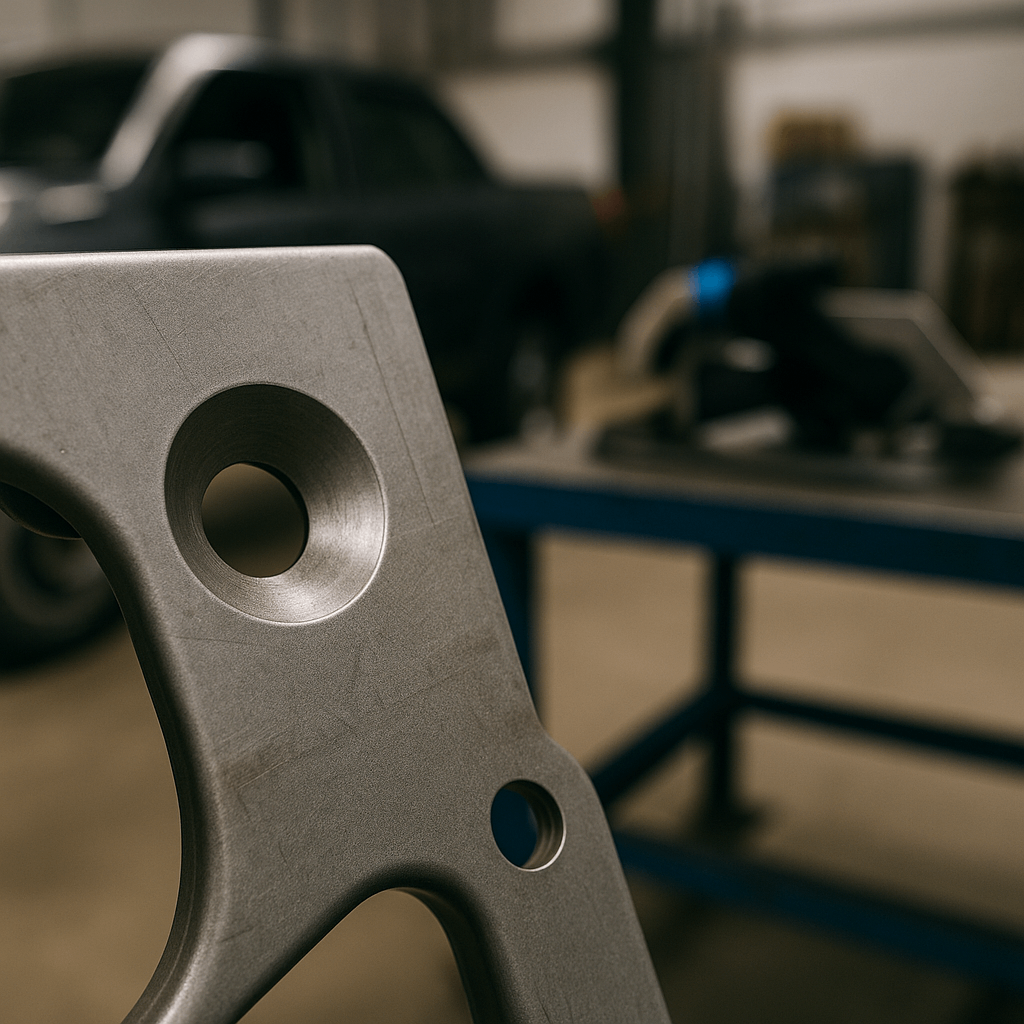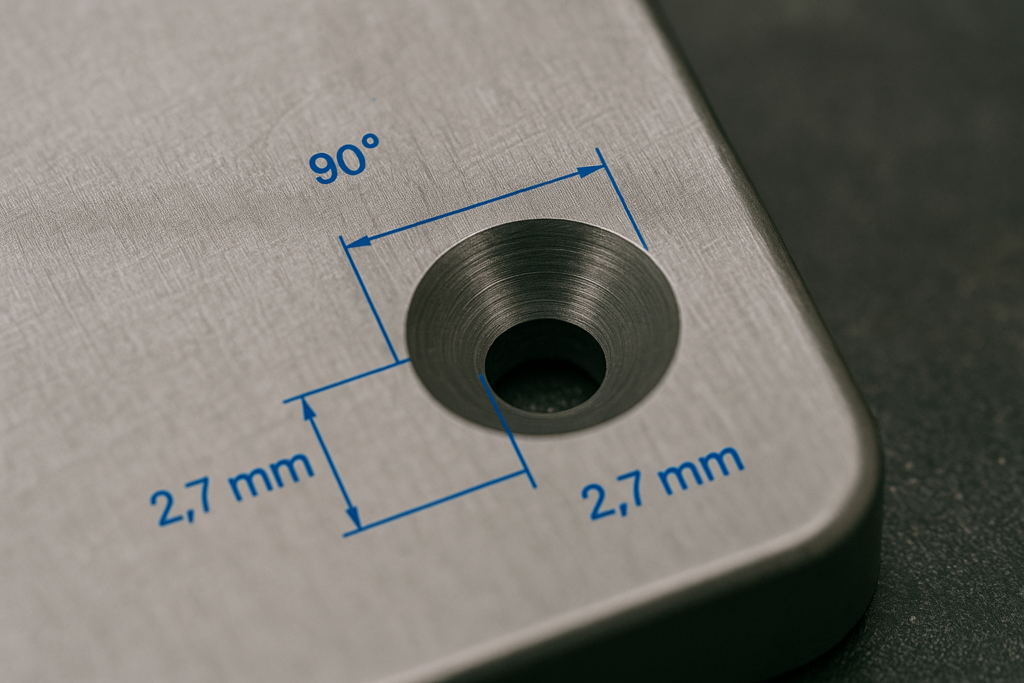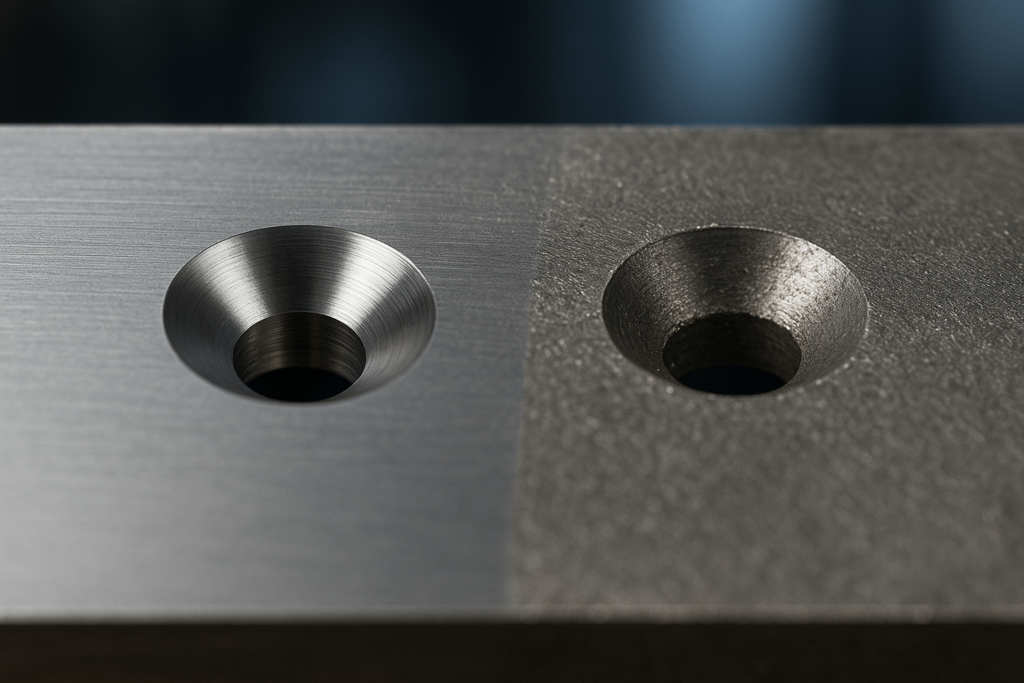TL;DR (for engineers & buyers): Proven 82°/90° sheet metal countersink formula with pilot‑hole rules (90–95%), DFM notes for machined vs. formed, and a validation workflow (FAI/CMM). Built by ISO 9001 & RoHS factory YISHANG—OEM/ODM friendly for wholesale runs.
At-a-glance: Angle systems (ASME 82° / ISO 90° / Aerospace 100°), depth equation, coating allowances, stainless galling fixes, and an RFQ checklist to get a fast, accurate quote.
In precision manufacturing, success is measured in microns. For wholesale buyers and engineers, reliability isn’t a goal; it’s a prerequisite. A single, poorly executed countersink can compromise an entire product line, leading to costly failures and project delays.
This isn’t just another technical guide. It’s a pragmatic framework born from over two decades of manufacturing experience, designed to help you mitigate risks and optimize your components for performance and cost-effectiveness while moving beyond basic formulas to a holistic methodology for mastering the sheet metal countersink so your parts meet specifications every time.
The Command Center: Instant Answers from Our Quick-Reference Workbench
Skip the guesswork—here’s a quick reference so you can grab 82°/90° countersink parameters instantly. Before diving into theory, our quick-reference workbench / diagram provides the immediate, reliable parameters you need for your countersink design.
Use this tool to get a robust starting point for your project, including critical pilot hole recommendations and proactive DFM (Design for Manufacturing) alerts to prevent costly errors before production begins.
Inputs: Fastener Standard (ASME/ISO), Fastener Size, Material Type, Material Thickness, Process (Machined/Formed).
Outputs: Recommended Major Diameter, Depth, Pilot Hole Diameter, DFM Warnings.
Diagram: A dynamic cross-section view of the fastener, material, and countersink.
With these initial parameters, we can now explore the engineering principles behind them. Understanding the “why” is crucial for making informed procurement decisions and collaborating effectively on complex projects.
Quick Reference (Typical Starting Points)

Always confirm against your fastener datasheet and drawing tolerances. Values below are starting points for DFM, not final inspection specs.
Metric (ISO, 90° flat head)
| Fastener | Head Angle | Recommended Major Ø (D) | Pilot Hole Ø (% of shank) | Depth Note |
|---|---|---|---|---|
| M3 | 90° | use datasheet head Ø (≈ 5.6–6.0 mm) | 90–95% | depth = (D − d) /(2·tan(θ/2)) |
| M4 | 90° | use datasheet head Ø (≈ 7.3–8.0 mm) | 90–95% | same formula; verify burr allowance |
| M5 | 90° | use datasheet head Ø (≈ 9.2–10.0 mm) | 90–95% | thin sheet: consider staged forming |
Imperial (Unified, 82° flat head)
| Fastener | Head Angle | Recommended Major Ø (D) | Pilot Hole Ø (% of shank) | Depth Note |
| #6 | 82° | use datasheet head Ø (≈ 0.270–0.290 in) | 90–95% | depth = (D − d) /(2·tan(θ/2)) |
| #8 | 82° | use datasheet head Ø (≈ 0.320–0.350 in) | 90–95% | check coating stack-up before finish |
DFM Reminders: For stainless (304/316), manage galling with lubricant and positive rake tools; for painted/powder-coated parts, oversize major Ø by +0.02–0.05 mm to maintain flushness after finishing; for very thin sheet (<1.0 mm), prefer machining or staged forming to avoid neck thinning.
Note: Always verify the mm/in system and head diameter against the fastener datasheet.
The Two Paths to Precision: A Tale of Cutting vs. Forming
Every countersink is created by either removing material (cutting) or displacing it (forming). This choice is a strategic decision that directly impacts cost, lead time, and final part performance.
The selection between a machined vs formed countersink is driven by your project’s specific requirements for precision, strength, and volume.
Scenario 1: The Aerospace Imperative
Consider an external fuselage panel made from 2024-T3 Alclad aluminum. Here, the demands are absolute. A protruding fastener head can significantly increase aerodynamic drag, a critical factor in fuel efficiency.
For this application, a machined countersink is the preferred choice for tight flushness and traceable tolerances. Using a specialized micro-stop cage, this process achieves exceptionally tight tolerances on angle (+/- 0.5°) and depth, ensuring perfect flushness without inducing stress in the material
Scenario 2: The Automotive Scale
Now, imagine a mounting bracket for an automotive infotainment system, produced in volumes exceeding 500,000 units annually. The key drivers are cost per unit and production speed.
Here, a formed countersink is the superior choice. This high-speed coining process not only meets the required tolerances but also strengthens the part through work hardening, increasing fatigue resistance—a critical benefit in high-vibration environments. This can significantly reduce per-unit costs compared to machining.

Scenario 3: The Medical Device Standard
For a surgical instrument from 316L stainless steel, biocompatibility and sanitation are paramount. A machined countersink provides a clean finish, but it must be followed by electropolishing to remove any microscopic burrs where bacteria could harbor.
This highlights how end-use requirements and necessary secondary operations are critical factors in the procurement decision, influencing both cost and lead time.
Comparative Analysis: Machined vs. Formed Countersinks
Table — quick scan: Machined vs. Formed countersinks for cost, precision, material effects and defects.
| Feature | Machined (Cut) | Formed (Coined) |
| Core principle | Material removal with countersink cutters or helical interpolation. | Plastic deformation using a forming press/coining punch. |
| Best applications | Thin sheets; hard/precipitation-hardened alloys; aerospace/medical; low–medium volume; tight flushness. | Ductile alloys (Al, CRS); high volume; where local work hardening is beneficial. |
| Effect on material | Preserves temper; minimal residual stress. | Local work hardening; may introduce residual stress and neck thinning if over-formed. |
| Precision & tolerance | Excellent control of angle/depth/finish (≤ 1.6 µm Ra with proper tooling). | Good; depends on tool quality, lubrication, material lot consistency. |
| Common defects | Burrs, chatter, tool wear, stainless galling if parameters are poor. | Orange peel, micro-cracking if ductility is exceeded, cone ellipticity from misalignment. |
| Cost structure | Low NRE, higher cycle time per part. | Higher NRE, ultra-low cycle time per part. |
The Source Code: Decoding the Rules of Material and Measurement
A successful countersink design relies on a deep understanding of material science and established engineering standards. This knowledge ensures that the final product is not only manufacturable but also reliable in its intended application.
The Material Behavior Matrix
The properties of the sheet metal are the most significant variable in your countersink formula. The material’s crystal structure dictates its response to the forming or cutting forces of a forming press or CNC machining center.
| Material | Formability | Machinability | Work Hardening | Key Design Recommendation |
| Aluminum (5052-H32, 6061-T6) | Excellent | Good | Low | Ideal for forming. For a countersink in aluminum, use a smaller pilot hole (90–95% of fastener shank) to provide material for displacement. Use sharp, high‑positive‑rake tooling for machining to avoid galling. |
| Stainless Steel (304, 316) | Fair to Good | Fair | High | Work hardens rapidly. For a stainless steel countersink, use lower surface speeds with higher feed to avoid rubbing. Forming requires higher tonnage and carries a greater risk of cracking—stage the forming depth if attempted. |
| Mild / Cold‑Rolled Steel (CRS) | Good | Excellent | Medium | A versatile all‑rounder. For a cold‑rolled steel countersink, both forming and machining are viable. Protect machined surfaces after processing to prevent corrosion. |
| High‑Strength Steel (e.g., AR500) | Poor | Poor to Fair | N/A | Forming is generally not recommended. Machining requires rigid setups and specialized carbide tooling to control heat and avoid tool failure. |
Standards Cheat Sheet (Angles & Systems)
Note: Angle conventions above are provided for design orientation. YISHANG is certified to ISO 9001 and RoHS; no other industry accreditations are claimed.
The YISHANG Methodology: A 5-Step Algorithm for Flawless Design
A reliable process is the foundation of a reliable supply chain. Our YISHANG Methodology™ is a systematic, five-step algorithm that translates design intent into a flawless, manufacturable part.
This isn’t just a process; it’s our commitment to quality and predictability, refined over 26 years of exporting to more than 50 countries.
Define Scope: Anchor the Design to Requirements
We begin by anchoring the design to its functional reality.
The Fastener: Specify the exact part number and material to determine head angle, diameter, and potential galvanic corrosion issues.
The Load Conditions: Will the joint be in shear or tension? Is it subject to vibration? This dictates the required joint strength.
The Functional Requirements: Define the required flushness tolerance (e.g., +0.000/−0.005″ (≈ +0.00/−0.13 mm)). This defines your acceptance criteria.
Initial Calculation: Establish the Theoretical Baseline
With requirements defined, we establish a perfect-world baseline using the fastener’s geometry. This number is our ideal target, which we then adjust for the realities of material behavior.
Material Compensation: Apply the Expert Adjustment
This is where experience elevates the design.
For Formed Countersinks: We manage material flow. For a countersink in aluminum, a pilot hole at 90-95% of the fastener’s shank diameter is a proven starting point.
For Machined Countersinks: We compensate for tool deflection and burr formation. The design must account for a subsequent deburring process to ensure perfect dimensional accuracy.
Process Selection: Optimize for Cost, Volume, and Quality
We help you select the optimal manufacturing process based on a clear cost-benefit analysis, considering both tooling investment (NRE) and per-unit pricing.
Validation Protocol: Prove the Design with Data

A design is only a hypothesis until it is validated. Our ISO 9001 certified process includes a rigorous First Article Inspection (FAI) protocol.
Measure everything: Use countersink gages matched to the design angle, a profile projector, or CMM to confirm major Ø, cone angle, roundness, and location.
Destructive testing (as needed): Cross‑section first‑off parts to examine grain flow (formed) or heat‑affected zone/smear (machined) and verify integrity.
Document: The validated parameters become the proven countersink formula for your part so subsequent lots are repeatable.
Worked Example — M5, 90° countersink (sheet thickness t = 2.0 mm)
Inputs
Fastener: ISO metric flat head M5, 90° (use your fastener datasheet for exact head Ø D and head height)
Nominal shank d = 5.0 mm; example head Ø D ≈ 9.2 mm (typical value — confirm on datasheet)
Baseline geometry
Cone half‑angle = 45°, so:
Depth h = ( D − d ) / ( 2 · tan(θ/2) ) = ( D − d ) / 2 → with D = 9.2, d = 5.0 ⇒ h ≈ 2.1 mmPilot hole: for formed countersinks, start at 90–95% of shank ⇒ 4.5–4.75 mm; for machined countersinks, pilot can equal the shank size when the countersink tool defines the cone.
Compensations
Finish allowance: If powder coat is specified, oversize major Ø by +0.02–0.05 mm (process‑dependent) to keep the head truly flush after finishing.
Deburr plan: Specify post‑process deburr and a cosmetic edge break (e.g., 0.1 × 45°) to eliminate proud burrs.
Inspection plan (excerpt)
Countersink angle 90° ± 0.5°; major Ø per head Ø call‑out; flushness target at assembly (define +/− tolerance on drawing).
Surface finish ≤ 1.6 µm Ra where exposed; burr height ≤ 0.05 mm; no cracks in formed region under 10×.
Surface Finish, Flushness & Burr Targets (Guidance)
Table — quality targets for surface finish, flushness and burr height.
Use the ranges below as starting targets for drawings. Adjust to customer standards and actual finishing specs.
| Face / Context | Process | Typical Surface Finish (Ra, µm) | Flushness at Assembly | Max Burr Height | Notes |
| Exposed cosmetic face | Machined | ≤ 1.6 | 0 to −0.05 mm (sub‑flush) | ≤ 0.05 mm | Break edge 0.1 × 45°; verify after coating |
| Exposed cosmetic face | Formed | ≤ 3.2 | 0 to −0.05 mm | ≤ 0.05 mm | Risk of orange peel on some lots; lubricant helps |
| Non‑cosmetic / internal | Machined | ≤ 3.2 | ±0.10 mm | ≤ 0.10 mm | Define functionally |
| Non‑cosmetic / internal | Formed | ≤ 6.3 | ±0.10 mm | ≤ 0.10 mm | Section first‑off if cracking risk |
Coating stack‑up allowance: For paint/powder, plan +0.02–0.05 mm major Ø growth or mask the countersink as a critical feature.

From Our Quality Lab: Troubleshooting Real-World Failures
We log FAI/CMM parameters so approved settings repeat across lots—and solve issues before they impact your production line. Here are insights from our quality lab on common issues.
Interactive Diagnostic Tool
Select the symptom you are observing to diagnose the probable cause and uncover a proven solution.
FAQ — Quick Answers for Engineers & Buyers
1) 82° vs 90° — which should I choose?
Follow your fastener system: inch‑series typically 82°, metric typically 90°. Mixing systems risks poor seating and joint loosening.
2) How big should the pilot hole be for formed countersinks?
Start at 90–95% of shank diameter; increase in 1–2% steps if cracking appears. For machined countersinks, the pilot can match the shank because the countersink cutter forms the cone.
3) How do I keep thin sheet from necking or tearing?
Use staged forming (progressive shallows), add a backer die, or switch to machining for sheets <1.0 mm. Reduce forming speed and apply lubricant.
4) Will forming weaken the part?
Forming locally work‑hardens material and can improve fatigue strength near the hole, but excessive forming can thin the neck. Validate with sectioning.
5) Can I mix an 82° screw with a 90° countersink (or vice versa)?
Not recommended. Mismatched angles create point contact, poor seating, and loosening under vibration. Always match screw head angle and countersink angle.
6) How should I specify flushness when a coating is applied?
Define flushness after finishing (e.g., 0 to −0.05 mm post‑coat) and provide the coating thickness range. Allow +0.02–0.05 mm on major Ø or mask the countersink if critical.
Your Partner in Precision Manufacturing
Mastering the sheet metal countersink is about creating a reliable, repeatable system. It’s understanding that the perfect outcome is the product of a holistic process that balances theory with proven manufacturing practice.
This deep manufacturing knowledge is the foundation of a successful partnership. If you’re looking for a supplier who can bring this level of expertise to your next project, our team is ready to help.
Contact our engineering team to discuss your project requirements.

